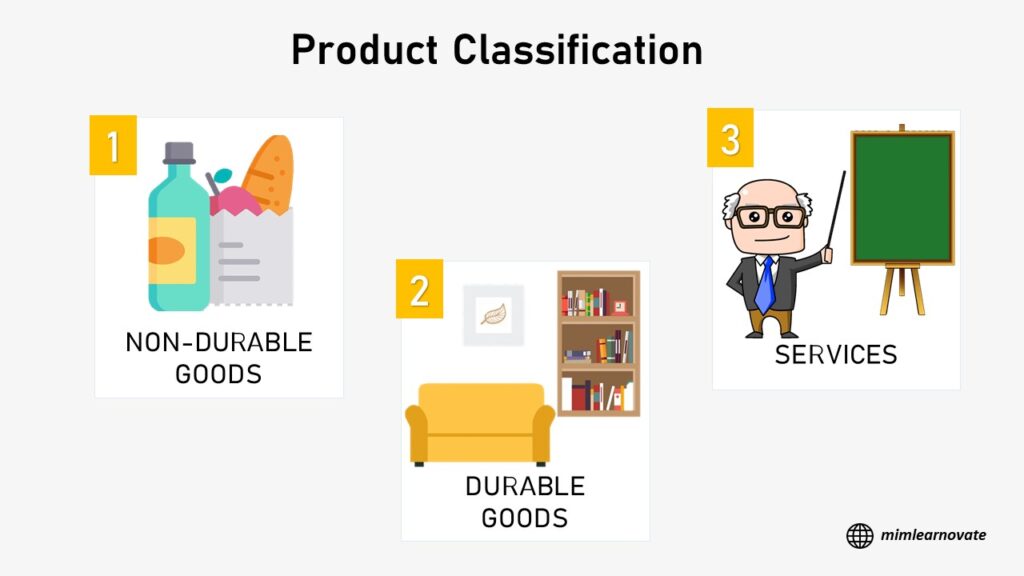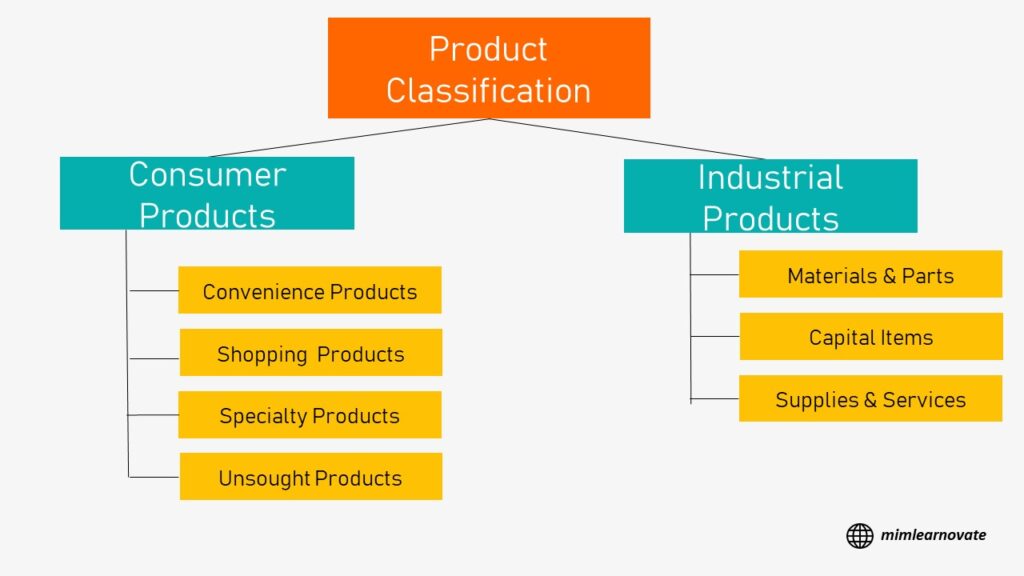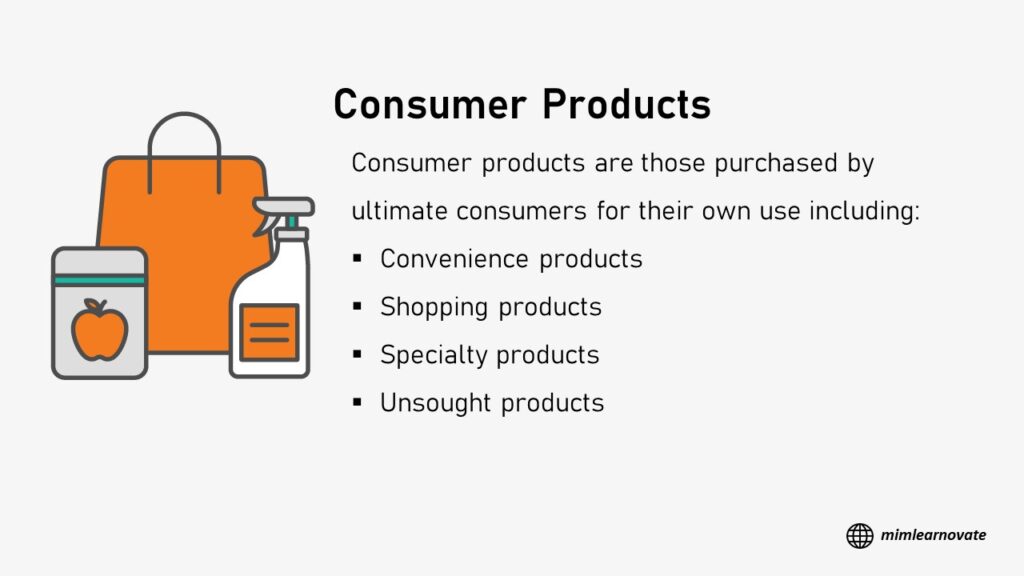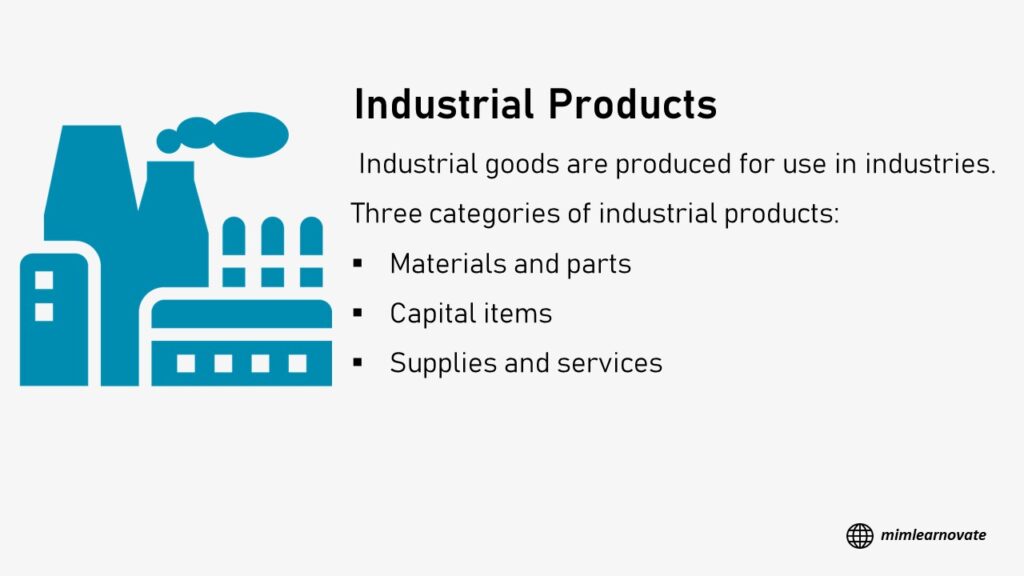In this article, you will learn about product classification, product types, and discuss the reasons of product classification.
Product classification is a marketing and business phrase that categorizes products according to how and why customers buy them.
These distinctions may alter how businesses advertise their products and may have an impact on other sales-related factors like pricing and distribution.
It is especially crucial for you to comprehend product classifications and their impacts if you work in marketing or sales.
Product Classification
Products can be categorized based on their tangibility and durability.
Non-durable goods include products like beer, soap, and food products that are often used only seldom and consumed quickly.

Products that are utilized over an extended period of time and often last for many years are said to be durable.
Examples include automobiles, furniture, and refrigerators.

Services are activities, advantages, and pleasures that are offered for purchase but are essentially intangible and do not give rise to property ownership. Haircuts, vacation packages, and banking services are a few examples.

There are two broad categories into which marketers have placed products and services depending on the types of customers that utilize them.
- Consumer products
- Industrial products
1- Consumer products
Consumer products are those purchased by ultimate consumers for their own use. These products are typically categorized by marketers using customer purchasing patterns.
These products are marketed differently because on how people choose to purchase them.

Consumer products include:
- Convenience products
- Shopping products
- Specialty products
- Unsought products

▶ Convenience products
Convenience products are consumer goods and services that the consumer typically purchases frequently, right away, and with the least amount of research, comparison and buying effort.
Typically, they are inexpensive and widely accessible. Through numerous distribution channels, including all retail stores, these products are made available to the public.
Example of Convenience products
Soap, detergents, candy, newspapers, and foods including rice, wheat flour, salt, sugar, and milk.
▶Shopping products
Consumers spend a lot of time and effort researching these products, comparing alternative brands carefully on suitability, quality, price, and style. Consumers buy these products less frequently.
These products are sold through a few selected distribution channels.
Example of Shopping products
Furniture, clothing, used vehicles, and major household appliances.
▶Specialty products
Consumer goods with unique qualities or brand image are referred to as specialty products since a significant group of customers is willing to make a special purchase effort.
Normally, consumers do not compare specialty goods. They only devote the time required to travel to retailers offering the desired products.
Although these dealers do not require convenient locations, they nevertheless need to advertise their location to customers.
Example of Specialty products
Sports cars, designer clothing, exotic perfumes, expensive home entertainment systems, photography equipment, and luxury goods.
▶Unsought products
Unsought products are consumer goods that a consumer is either unaware of or aware of but does not typically consider buying.
Most innovations are unsought after until they are made known to the consumer through advertising. Unsought goods require a lot of advertising, personal selling, and other marketing efforts by their very nature.
Example of Unsought products
Life insurance, home security systems, reference books, funeral services, encyclopedias, fire extinguishers and blood donations to the Red Cross.
Marketing considerations for consumers products Table
| Marketing Considerations | Convenience | Shopping | Specialty | Unsought |
| Customer Buying Behavior | Frequent purchase, little planning, little comparison or shopping effort, low customer involvement, | Less frequent purchase, much planning and shopping effort, comparison of brands on price, quality, style | Strong brand preference and loyalty, special purchase effort, little comparison of brands, low price sensitivity | Little product awareness, knowledge |
| Price | Low price | Higher price | High price | Tends to vary |
| Distribution | Widespread distribution, convenient locations | Selective distribution in fewer outlets | Exclusive distribution in only one or a few outlets per market area | Tends to vary |
| Promotion | Mass promotion by the producer | Advertising and personal selling by both producer and distributors | More carefully targeted promotion by both producer and distributors | Aggressive advertising and personal selling by producer and distributors |
| Examples | Toothpaste, magazines, laundry detergent | Televisions, furniture, clothing | Luxury goods, such as Rolex watches or fine crystal | Life insurance, reference books, blood donations |
2- Industrial products
Business organizations buy industrial products to employ in their operations or for further processing.
In general, industrial goods are produced for use in industries. The distinction between industrial and consumer products is made based on the use for which they are purchased.

Example of Industrial product
A lawnmower is a consumer product if it is purchased by a consumer for household purposes. The lawnmower is an industrial product if the same customer purchases it to be used in a landscaping business.
There are three categories of industrial products.
- Materials and parts
- Capital items
- Supplies and services

▶Materials and parts
Industrial goods known as materials and parts are used in the buyer’s product through further processing or as components.
They consist of components as well as raw materials and manufactured materials and parts.
→Raw Materials
Many small farmers supply the products, which are then given to marketing intermediaries to process and market.
Natural products typically require a lot of transportation to get from the producer to the consumer because of their high bulk and low unit value. They are provided by fewer, larger producers, who frequently sell to industrial customers directly.
Farm products (wheat, cotton, animals, fruits, and vegetables) and natural products (fish, timber, crude petroleum, iron ore) consist of raw materials.
→Manufactured Materials and Parts
The majority of manufactured goods and components are sold straight to industrial customers.
The most essential marketing criteria are price and service, with branding and advertising typically playing a less major role.
Component materials (such as iron, yarn, cement, and wires) and component parts (small motors, tyres, castings) are included in manufactured materials and parts.
Example of Materials and parts
Examples of raw materials include agricultural products, crude oil, and iron ore. Produced materials include iron, yarn, cement, and wires. Component parts include small motors, tyres, and castings.
▶Capital items
Industrial products that aid in the production or operations of the buyers are referred to as capital items. Capital items consists of :
- Installations
- Accessory Equipment
→Installations
Installations are typically purchased directly from the maker following a thorough decision-making process because they are large purchases.
Buildings (factories, offices) and fixed machinery (generators, drill presses, large computers, lifts) composed of installations.
→Accessory Equipment
These products are not included in the final package. They serve just as production aids and have a shorter lifespan than installations.
Because the market is divided geographically, there are many customers, and the orders are often small, the majority of accessory equipment dealers employ intermediaries.
Portable factory equipment and tools (hand tools, lift trucks), as well as office equipment, are examples of accessory equipment (fax machines, desks).
▶Supplies and Services
Industrial products like supplies and services never make it into the final product.
→Supplies
Supplies includes:
- Operating supplies (lubricants, coal, computer paper, and pencils)
- Repair and maintenance items (paint, nails, brooms)
Since supplies are typically purchased with little effort or comparison, they are the convenience goods of the industrial field.
→Services
Business services include:
- Maintenance and Repair services (such as window washing and computer repair).
- Business advisory services (legal, management consulting, advertising).
Typically, these services are provided under a contract. Small producers frequently offer maintenance services, while original equipment manufacturers frequently offer repair services.
Reasons for Product Classification
For a variety of reasons, experts categories products into groups.
During a product’s life cycle, product classifications can affect a number of decisions, including how businesses market their products, their prices, the kind of customers that purchase them, and how much demand there is for them.
The following reasons are additional ones for which experts classify products:
→Marketing Strategies
The classification of a product can have an impact on both the campaign’s emphasis and the marketing budget.
For instance, while selling a specialty item, a company is less likely to spend money on setting up a focus group to test its product. They may instead invest on managing their brand.
→Invention
When choosing which products to produce, a firm may take product classes into account. A company may decide to focus on one type of advertisement because marketing strategies for each type of product vary, which would restrict the products they might produce.
The decision of a firm to create a product can be influenced by the market demand for that product, which shapes how experts create product categories.
→Product Pricing
A product’s classification may have an effect on how much distributors and retailers charge for it. Convenience items and required purchases are typically less expensive than specialty items or informed purchases because buyers respect their accessibility and necessity.
In addition to being more routine, convenience and necessary items also tend to be less expensive, like meals.
Companies offering convenience and required goods must set a lower price for these items in order to compete with other brands because consumers have less brand loyalty for products in these categories.
→Product Demand
A product’s classification frequently has an impact on consumer demand. Customers typically opt for mandatory and convenient purchases over specialty and informed ones. This affects how businesses produce these products and how marketing departments advertise them.
Products that specialize in educating consumers about their options may need to spend more time and money marketing their products since consumers may need more encouragement to make purchases that they don’t need as frequently.
Conclusion
Product demand, pricing, and the primary demographic that advertisers can target with their marketing efforts can all be determined with the help of product classification.
Other articles
Please read through some of our other articles with examples and explanations if you’d like to learn more about marketing.
Management
- Human Resource Management
- Management Information System
- Why is Information Governance Important?
- How Data Analysis Is Changing Information Governance?
- The St. Gallen Management Model
- System-Oriented Management
- Tools Transforming Knowledge Management
- Levels of Management
- Information Management Software
- Tools for Information Management
- Information Governance vs Records Management
- Management Information System Books
- Greenwashing: A Case Study on DWS
- Greenwashing Examples
Statistics
Marketing
- Strategic marketing planning
- Marketing Environment
- Consumer buying decision process
- Factors Influencing Consumer Behavior
- Product Positioning
- Target Market Strategies
- Market Segmentation
- STP Process
- Data Analysis Process
- Consumer Adoption Process
- Branding
- Product Life Cycle
- Product Attributes
- Price Discrimination
- Service-Based
- Company Vs. Product-Based Company
- Product Classification
- Penetration Pricing and Price Skimming
- Case Study of Nestle
- Fast-Moving Consumer Goods
- Motorola’s Customer-Defined, ‘Six-Sigma Quality
- PEST And a SWOT Analysis
- Web Design Company Vs. a Web Designer
- Internal and External SWOT Analysis
- Strategic Opportunism
Marketing Analysis
ChatGPT
- Paraphrase Text
- PowerPoint Slides
- Learn Languages
- Write Code in Python
- Write Literature Review
- Document Review
- Job Interview Preparation
- Prompts For Students
- Write Cover Letter
- Write Resume
- Write Code
- Job Applications
- Write SQL Queries
- Write Excel Formulas
- Academic Writing
- Translate Text
- Keyword Research
- Business Idea Generation
- Business Entrepreneur
- Use ChatGPT on WhatsApp
- Virtual Research Assistant
- Meta-Analysis in Research
- Large Documents
- Hypothesis Development
- Share ChatGPT Responses
- Text Analysis
- Upload PDF on ChatGPT
- Books ChatGPT




1 Comment
Hello mimlearnovate.com administrator, Thanks for the well written post!